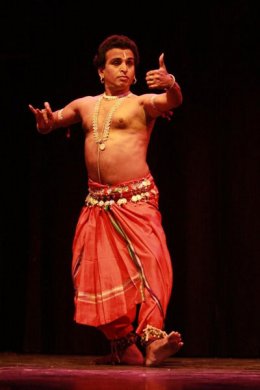
|   |

|   |
Glimpses of the final day of the Uday Shankar Dance Festival - Nita Vidyarthi e-mail: nitavidyarthi@gmail.com December 22, 2014 On the opening of the final evening of the Uday Shankar Nrityotsav 2014, organised on the occasion of the maestro’s 114th birth anniversary at Rabindra Sadan, Kolkata, by the West Bengal State Music Academy, Department of Information and Cultural Affairs, Government of West Bengal, Guru Gajendra Panda stormed the stage with his ‘Ardhanarishwara.’ A torchbearer of the Guru Debaprasad Das style, the dancer presented the traditional piece choreographed by him with a display of zest. Encircling the stage with anjali hasta for pushpanjali and then trikhandi pranam, he began his presentation of “Champeya gaurardhya sharira kayaayi” set to raag Malaba Kaushiki, taal triputa and ektaali, the music composed and sung by Lakshmikant Palit. The composite androgynous form of Shiva and Parvati illustrating the inseparable forms of Purusha and Prakriti for a harmonious balance of the universe was depicted by crisp movements and excellent poised bhangis and bhramaris as in “Jhanatkvanatkankana nupurayai padabjarajatphanin upuraya.” The clarity of mudras and movements to illustrate the lines “Divyambarayai cha digambaraya” were an outcome of years of practice and understanding. Lying prostrate on the ground, the dancer expressed effectively “Jagajjananyai jagadadekapitre” with devotional fervour. The choreography had a good measure of nritta interspersed with the signature sabdaswara pata of the Debaprasad style at the beginning, amalgamated with abhinaya to accentuate the impactful stretched movements with the facial expressions. An interesting mannerism of the tossing of his head around 180 degrees added an innovative appeal to the dancing. Especially impressive was “Vishalnilotpal lochanayai vikashipangeykaruhalochanayai” where he used his eyes to unfold the rich imagery of the male and female principles of Shiva and Parvati to evolve the lyrical beauty of the stotra. However, a bit more of the lasya elements would have made the performance more enjoyable. 
Gajendra Panda
Veteran Kathak dancer Roshan Datye and her two well-trained dancers presented five items covering briefly the entire Kathak repertoire beginning with a traditional ‘Durga Stuti’ followed by a pure dance item ‘Roop Kathak’ demonstrating the elements of nritta - uthan, amad, thaat and a short paran. The footwork of the two dancers Dhanasree and Abha showed a fine taiyari and a slight semicircular hand movement with a delicate ‘lachak’ in the tatkar looked really beautiful and was an uncommon composition of Datye. ‘Utsav’ was based on young Krishna playing Holi in Brindavan. Set to the semi-classical genre with the song “Dekho (kaise) hori ke khilaye ban ban doley,” the fast numbered duet adorned with swaying moves was an enjoyable duet. The abhinaya by Roshan Datye portraying khandita nayika was short of facial expressions and did not rise above mediocrity and the dancer looked tired. However, the predominant Rudraroop in the concluding Shiva Tandav was riveting, compact, well coordinated with some interesting compositions of still points, fine music and competent dancing by the two young dancers. Shibnarayan Banerjee and his Odissi group ventured into a choreographic presentation of the Guru Kelucharan Mohapatra-Pandit Bhubaneswar Misra composed masterpiece “Ahi neela shailo.” The dramatized version in the choreography was an unusual venture but lacked neatness at certain points due to the lack of full coordination of the dancers. 
Siddartha
The festival’s concluding presentation was Hermann Hesse’s ‘Siddartha’ directed by Ileana Citaristi and the members of Art Vision, Bhubaneswar. The abstract novel of the journey of a young Brahmin Siddharth in search of self-realization to live the life of a wanderer experiencing hunger, pain, frustration, immersing in vices and ultimately reaching the river where a boatman directs him to listen to the river and search within himself for an understanding of the truth was presented in well-choreographed Odissi by Ileana Citaristi. The visual effect of the presentation, especially the light design and sets was highly attractive with the appeal enhanced by the Malakhamb artistes from Puri. The Odia poetry was by Devdas Chotray and music by Annada Prasanna Pattanaik and Sachidanand Das. Dr. Nita Vidyarthi is a critic of performing arts, specialising in dance, dance theatre and expressions and is a regular contributor to The Hindu, and the Statesman Kolkata in dance, vocal music and theatre. She is trained in Kathak, Bharatanatyam and Manipuri as well as vocal, semi-classical music and Rabindra Sangeet. A Science communicator, Ph.D. in Polymer Science, Commonwealth Scholar and a retired Professor of Chemistry, Nita devotes most of her time to dance and theatre writing. |